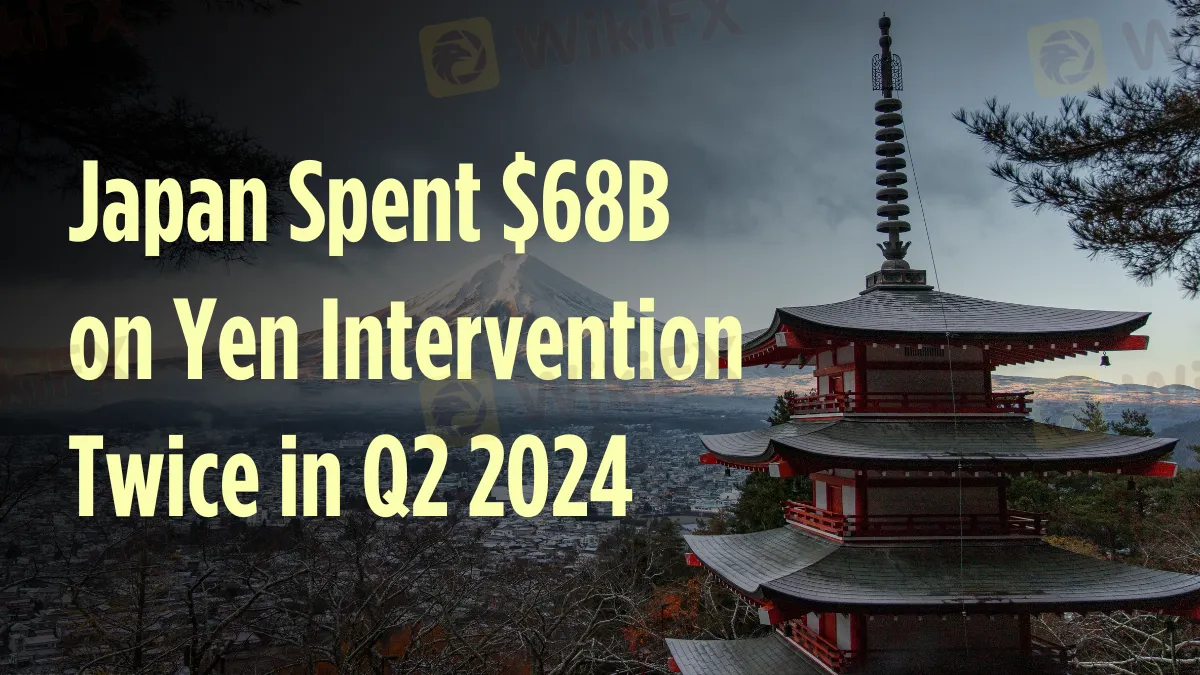简体中文
繁體中文
English
Pусский
日本語
ภาษาไทย
Tiếng Việt
Bahasa Indonesia
Español
हिन्दी
Filippiiniläinen
Français
Deutsch
Português
Türkçe
한국어
العربية
Japan Spent $68B on Yen Intervention Twice in Q2 2024
Abstract:Japan spent $68 billion on yen interventions in Q2 2024. Despite record spending, the yen's recovery was brief, with recent rate hikes aiding its strength.

In the second quarter of 2024, Japan made major foreign currency market interventions, spending a record $68 billion to stabilize the yen. The Ministry of Finance carried out these measures on April 29 and May 1, according to a comprehensive report issued Wednesday.
Japan spent about ¥5.9 trillion (about $40.6 billion) on April 29 and ¥3.9 trillion on May 1. This large spending was intended to maintain the yen, which had fallen to its lowest level in decades. Despite these significant financial efforts, the interventions had only a brief impact and did not alter the fundamental market trend.

The report also stated that no other interventions happened after these two dates. According to previous estimates, Japan may have sold US Treasury bonds and other foreign assets to fund these actions. However, the immediate effect of these actions could have been more minimal. However, they did temporarily prevent some investors from betting against the yen due to concerns about future action.
To maintain the yen, Japanese policymakers spent an extra ¥5.5 trillion last month. A complete summary of these most recent measures is scheduled to be issued in November.
As Japan's attempts to reverse the yen's drop come to a close, the currency has lately exhibited a robust comeback, backed by a shrinking interest rate disparity. Last Monday, the Bank of Japan increased its policy rate by 0.25 percentage points to 0.1% and announced a decrease in asset purchases. Following recent market disturbances, there is also speculation that the Federal Reserve would decrease interest rates by a higher amount than predicted.
Stay updated on Japan's $68 billion yen intervention and other financial news by visiting WikiFX's news page for the latest insights and reports.

Disclaimer:
The views in this article only represent the author's personal views, and do not constitute investment advice on this platform. This platform does not guarantee the accuracy, completeness and timeliness of the information in the article, and will not be liable for any loss caused by the use of or reliance on the information in the article.
Read more

Saxo Bank vs. Fusion Markets: A Straightforward Broker Comparison
When it comes to choosing a forex and CFD broker, traders often face a key question: do you go with a trusted, global institution like Saxo Bank, or a low-cost, flexible option like Fusion Markets? Both brokers offer unique advantages, but they’re built for very different types of users.

FXTM Launches New Client Promotion in Malaysia
FXTM, a well-established and trusted name in the trading industry, has launched an exclusive promotion for new clients in Malaysia. Running from June 16 to July 15, 2025, the New Client Promotion offers newcomers the chance to receive up to $120 in cash rewards, plus extra trading cashback of up to $7 per lot.

FXGT.com: A Closer Look at Its Licences
In an industry where safety and transparency are essential, the regulatory status of online brokers has never been more important. For traders seeking to protect their capital, ensuring that a platform operates under recognised and stringent oversight can make all the difference. Keep reading to learn more about FXGT.com and its licenses.

What WikiFX Found When It Looked Into M4Markets
In the world of forex trading, choosing a reliable broker is one of the most important decisions a trader can make. With scams and fake companies becoming more common, many traders turn to WikiFX, a global platform that checks and lists the details of over 60,000 brokers. In this article, we will be taking a closer look at a broker named M4Markets.
WikiFX Broker
Latest News
Inside MBI: The Billion-Dollar Ponzi Scheme That Shook Malaysia
ZFX: A Closer Look at Its Licences
Should you buy or sell US dollars in the next three to six months?
Tradehall Broker Review 2025: Read Before Trade
XM Rolls Out New Forex Trading Competition Platform for 2025
Tether Freezes $12.3 Million in USDT Over Money Laundering Concerns
MiCA Unlocks EU Crypto Market, but National Tensions Rise as Gemini and Coinbase Near Approval
Retirement Dreams Shattered: Don't Do This To Yourself!
Philippines Sets Southeast Asia’s First Crypto Regulatory Framework
EU Regulators Imposed Over €71M in Sanctions in 2024, ESMA Calls for Enforcement Convergence
Currency Calculator


